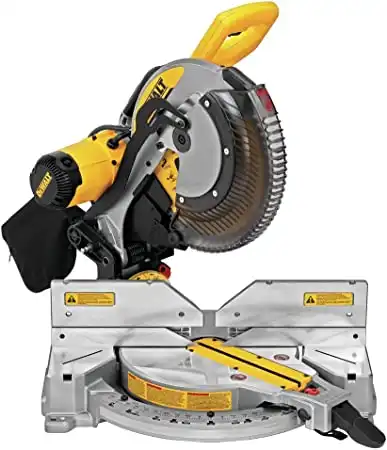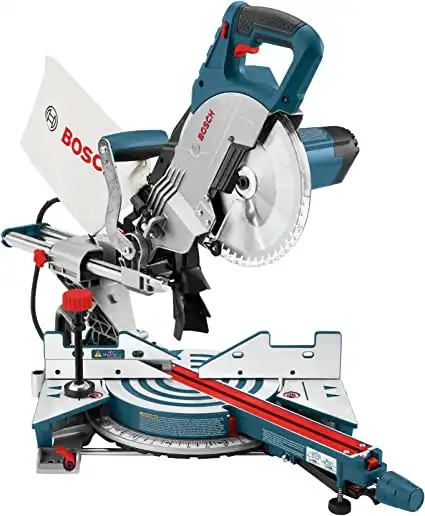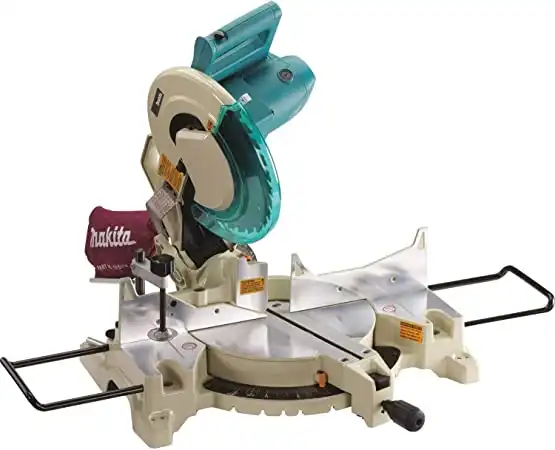
Miter saws are stationary or benchtop power tools that provide reliable, accurate, and repeatable cuts. They accomplish this by keeping the blade on a fixed trajectory. They are fantastic for crosscuts, which divide wood in half (as opposed to dividing it down the middle along the long axis).
A miter is an angled cut.
Most miter saws can make 45 degree cuts in lumber in addition to the standard 90 degree cuts.
They’re used to cut longer pieces of wood into shorter pieces quickly and accurately.
The most basic project that benefits from a miter saw are picture frames. By joining four sides together that have been cut at true 45 degree angles, picture frames can be built quickly and accurately.
More complex jobs like segmented bowls with eight, ten, or even twelve sides are accomplished with the accuracy and stability of a miter saw.
Miter saws are also indispensable for cutting and installing crown molding. Crown molding pieces must join each other at compound angles and miter saws provide the accuracy needed for clean joints.
A miter saw can miter, which is to pivot left to right to create mitered cuts. That’s the only angle adjustment available in these saws.
A compound miter saw can miter but it can also bevel, which is to tilt side-to-side. Introducing a bevel and a miter creates a compound cut which is more complicated. This is useful for crown molding or other complex geometries.
Most miter saws have preset stops along common angles, 90 and 45 degress being the most common. But sometimes, miter saws include strange angle settings like 22.5 degrees or 33.9 degrees.
Ever wondered what those other odd angle settings are for?
15 degrees lets you cut pieces for 12-sided shapes and 22.5 degrees let you cut pieces for 8-sided shapes. Both are commonly used for making segmented bowls.
Some of the other non-whole degree increments (like 22.5, 31.6, or 33.9) are used mainly when cutting crown molding. Some crown molding is too tall to be cut on miter saws when stood on end. These strange degrees set in both the miter and bevel adjustments allow you to lay tall crown molding flat on the saw’s bed and achieve 45 degree angles. Cool, huh?
To the first question, almost certainly. They make quick work of cutting down lumber into manageable lengths. Many beginner woodworking projects need only a miter saw (along with a drill and orbital sander). We consider this to be one of the necessary tools for any workshop.
To the second question, maybe. They’re great for complex cuts but most weekend warriors would rarely encounter these. Still, it’s so handy when those rare occassions arise. Also, if you’re planning on installing crown molding, you will definitely need a compound miter saw.
The Quick Answer
The DEWALT DWS716XPS is our top choice.
- It delivers a bunch of power
- It includes an innovative Cutline system that tells you where the blade will cut
- It usually costs less than the competition
MAKITA LS1221
MAKITA is a brand with a loyal following. It’s storied brand is over 100 years old, so they know power tools.
The LS1221 features a 15 amp motor that provides plenty of power and endurance for pretty much any lumber you’d need to cut. With a 12″ blade, the MAKITA has a lot of cutting capacity. It’s direct drive system means that there won’t be any internal belts slipping during strenuous cuts.
We noticed a bit of kick on this saw. There’s no soft-start circuitry, which comes standard on other saws. It’s not a deal breaker, but rather something to be aware of.
The fence is adequately sized at 4-1/2″, but it includes a novel pivoting fence that adds an additional inch to bring the height to 5-1/2″. This is especially useful for tall stock like crown molding.
Miter stops are located at common intervals between 90 and 45 degrees. We wish there were bevel stops like there were on other saws. A digital angle gauge can help alleviate any guesswork when introducing beveled cuts to your workpiece. Miter capacity is 45 degrees left and right and bevel capacity is up to 48 degrees on one side.
The saw is fairly light at 37 lbs. We had no trouble moving it around when needed. It uses a D-handle located on right side of the blade from the operator’s perspective. It’s nice for right-hand dominant folks but our lefty friends might feel less comfortable.
There’s an integrated vertical vise that helps clamp down long boards. Extension wings also help to keep workpieces stable before and after the cut.
Overall, we felt this saw was solid and made true and accurate cuts.
DEWALT DWS716XPS
DEWALT is another reliable brand that continues to offer well-built machines to help us make sawdust. The 716XPS is a feature-laden entry into this comparison that we really enjoyed using.
The saw has plenty of power on tap with 15 amps. The 12″ blade included in the saw has no problem cutting through lumber, including beefy 4×4 posts. At 41 lbs, the 716XPS is neither too light or too heavy. It definitely won’t move on you when presented with heavy cuts.
The 716XPS is a dual bevel miter saw, which means it can miter both left and right as well as bevel (tilt) to both sides. This may seem like a luxury (and it is to a degree), but it’s really useful when making cuts on a large quantity of long material. Instead of having to swing large boards around your shop or garage to compensate for a saw’s single bevel, this saw can accomodate you by beveling in both directions.
There are a bunch of positive miter stops (14, in fact!) which make common miters a cinch to dial in. The bevel gauge also includes positive stops along the way to make common bevel angles easier to lock in.
The fence is particularly tall for this saw class, which is really useful for large stock. It measures at a whopping 6-1/2″ tall, which allows for most common boards to be cut on end with full support. A fence this massive can get in the way for beveled cuts so the top halves of the fence can slide out of the way when needed.
The most compelling feature of the 716XPS is the integrated cutline system. While some saws use lasers to indicate the projected kerf line, the 716XPS projects a shadow of the blade itself onto the workpiece, which is arguably more accurate since a laser can lose adjustment but a shadow will never lie. The DEWALT acheives this with lights mounted on the handle that shine downwards over the blade and onto the workpiece.
With it’s solid construction, flexibility, and accuracy provided by the unique Cutline system, the 716XPS is a solid contender for the best miter saw to buy for the workshop.
BOSCH CM8S
We at WWC have always been fans of the German engineering behind the BOSCH logo. The CM8S is no exception. It’s smaller in blade diameter than the other two saws, but it’s still very capable.
With the sliding mechanism and blade configuration, the CM8S brings cut capacities on par with other 10″ miter saws. You might not be able to power through 4×4 posts in one shot, but just about anything else is fair game for this compact unit.
The BOSCH spins the blade at a quick 5600 rpms with 12 amps under the hood. Both bevel stops and miter stops are included in this saw to make compound adjustments a breeze.
There’s also a front stabilization foot that’s not found on other units. This extra support is located directly under the miter control arm and provides additional support for this compact saw. Also, expanding base extensions increase the footprint of the saw by 60% to accommodate larger pieces of lumber.
At 37 lbs, the CM8S was pretty easy for us to move around the garage or jobsite. BOSCH placed the handle on the saw’s center of gravity so transporting the miter saw is a well-balanced operation.
The handle is oriented vertically and is located in the center of the saw. Left-hand dominant and right-hand dominant users will feel equally comfortable using this saw. We often find ourselves switching hands depending on the cut and the BOSCH CM8S provides a solution that’s both ergonomic and flexible.
The included blade guard is completely transparent, which is useful during the last portions of the cut. Other blade guards are semi-opaque which can decrease visibility for a portion of the cut.
We really liked the CM8S from BOSCH. It’s a great, compact unit that can handle most jobs thrown at it.
So Which Miter Saw is the Best?
We’ve summarized the strengths and weaknesses of each miter saw above. We’ll continue to pit them against each other below to determine which is the top rated miter saw for your workshop. Beyond these summaries, full reviews for each tool can be found here:
Scoring will be based on each miter saw’s performance in four categories. Also, units can score equally if deserved in a particular category (e.g. a first, second, third, etc isn’t forced). For this comparison, the max score possible is set at 100 and the minimum score is 20.
Which Miter Saw is the Most Capable?
Exemplary = 25 points
Satisfactory = 15 points
Below Average = 5 points
Capability has two sub-categories: cut capacity and power.
In regards to cut capacity, the DEWALT and MAKITA are the clear winners with their much larger blades. 12″ can cut through just about anything as well as many stacked pieces of lumber. The BOSCH is going to have a harder time with its 8-1/4″ blade. It can cut almost anything but might need to make multiple passes to get through beefier stock.
In regards to power, DEWALT and MAKITA are again the top picks in this category with 15 amp motors. The 12 amp motor on the BOSCH is adequate wouldn’t stack up nicely against the other two.
DEWALT and MAKITA earn 15 points, BOSCH earns 5 points.
Which Saw Has the Most Features?
Exemplary = 25 points
Satisfactory = 15 points
Below Average = 5 points
The defining feature among this group of miter saws is the Cutline system on the DEWALT. The other two saws don’t include anything comparable to help guide us towards the final kerf line so DEWALT shines (literally) in this category.
The BOSCH includes everything we wanted and comes with the standard assortment of features.
The MAKITA lacked bevel stops. This made it more difficult to zero in on exact bevel angles. We could easily remedy this with a digital angle gauge but it’d be nice to have an integrated solution like the other two contenders.
DEWALT earns 25 points, BOSCH earns 15 points, and MAKITA earns 5 points.
Which Miter Saw is the Most Comfortable to Use?
Exemplary = 25 points
Satisfactory = 15 points
Below Average = 5 points
The DEWALT and MAKITA are both over 40 lbs and include the standard locks and handles to facilitate mobility. They also both include D-handles, which work fine but are trickier to use when using left-handed.
The BOSCH is the hands-down winner in this category with its sub-40 lb weight and handle configuration. By integrating a vertically-oriented handle, both left- and right-hand dominant users will feel at ease using the saw for all sorts of cuts.
BOSCH earns 25 points, MAKITA and DEWALT earn 15 points.
Which Saw is Priced the Lowest?
Exemplary = 25 points
Satisfactory = 15 points
Below Average = 5 points
Depending on the day and manufacturer discounts, prices can fluctuate. We’ve kept an eye on the prices of these tools and the spread isn’t too extreme. That being said, the DEWALT consistently comes in just under $400 while the MAKITA and BOSCH hover above $400.
Again, the price differentials aren’t large, but the DEWALT is priced aggressively enough to allow an additional blade upgrade while matching the costs of the other two units.
DEWALT earns 25 points. BOSCH and MAKITA earn 15 points.
Final Results
The DEWALT DWS716XPS takes the top spot in our comparison with its impressive power, innovative Cutline system, and aggressive price. We were very intrigued by this miter saw and we’re sure it’ll satisfy all your woodworking needs in your shop.
BOSCH’s CM8S is a great choice for those looking for a solid, yet compact miter saw. Check this one out if processing thicker materials isn’t a concern for you.
The MAKITA LS1221 is a fine miter saw, but it just doesn’t provide any of the compelling extras found in the other two units. It’s a solid saw and those that are familiar and loyal to the MAKITA brand will have no complaints with the LS1221.




